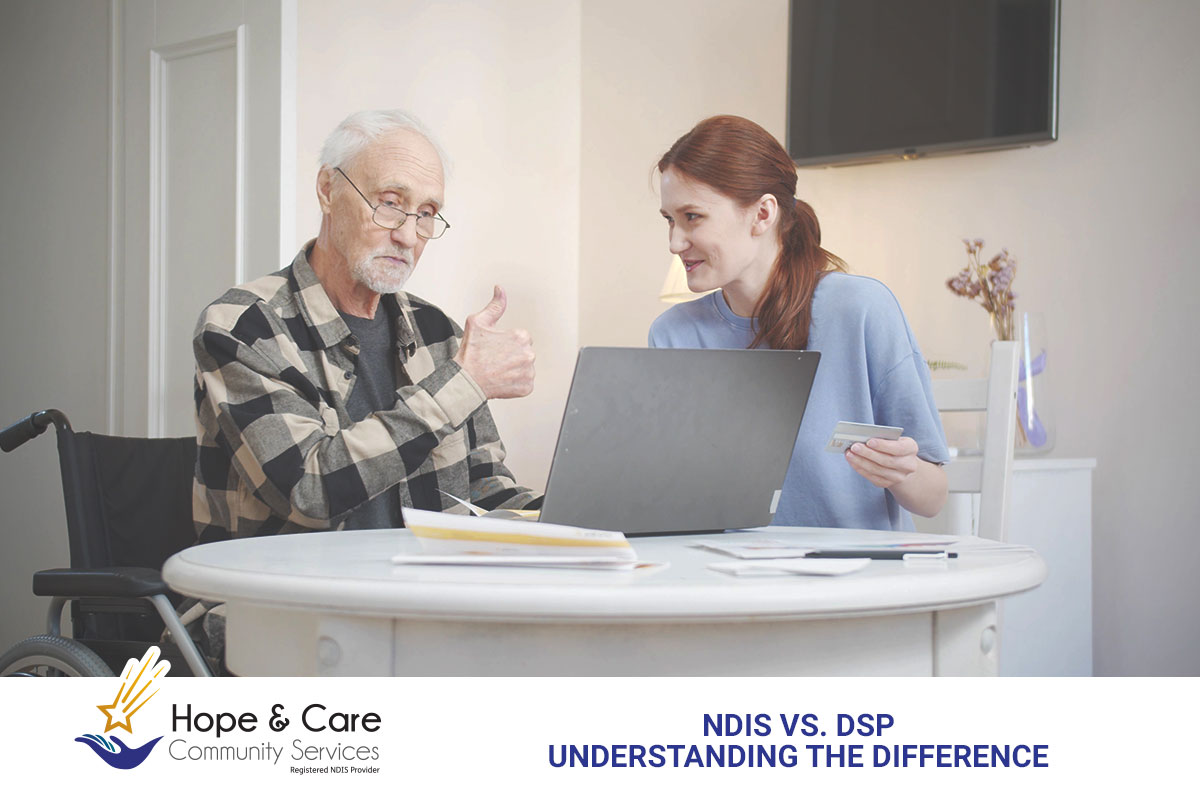
When it comes to disability support in Australia, two of the most important programs are the National Disability Insurance Scheme (NDIS) and the Disability Support Pension (DSP). Both provide essential assistance for people with disability, but they serve very different purposes.
At Hope & Care Community Services, we often hear questions like: What is the difference between NDIS and DSP? Can you receive both? Does NDIS funding affect DSP? This guide answers these questions, explains how the two programs work and shows how you can access both supports at the same time.
What is the NDIS?
The National Disability Insurance Scheme (NDIS) funds tailored supports for people with permanent and significant disabilities. Unlike welfare payments, the NDIS focuses on helping people achieve independence, meet personal goals and take part in everyday life.
What Does the NDIS Cover?
NDIS funding can provide support for:
- Personal care and daily activities
- Household tasks such as cleaning or meal preparation
- Transport to education, employment or community activities
- Allied health therapies like occupational therapy and physiotherapy
- Assistive technology, mobility aids and equipment
- Home modifications to improve accessibility
- Community and social participation programs
Who is Eligible for the NDIS?
You may qualify for the NDIS if you:
- Have a permanent disability that impacts your daily activities
- Are under 65 years of age at the time of applying
- Are an Australian citizen, permanent resident or Protected Special Category Visa holder
Once accepted, you will receive a personalised NDIS plan that outlines your funding and the supports available.
What is the Disability Support Pension (DSP)?
The Disability Support Pension (DSP) is a fortnightly income payment from Centrelink. Unlike the NDIS, which funds services, the DSP provides financial assistance to cover everyday living costs.
What Can DSP Be Used For?
You can use the DSP to pay for:
- Rent or mortgage
- Food and groceries
- Utilities and bills
- Medical expenses not covered elsewhere
Who is Eligible for the DSP?
To qualify for the DSP, you must meet both medical and non-medical criteria.
Non-medical requirements include:
- Being aged between 16 years and Age Pension age
- Meeting residency requirements
- Passing an income and assets test
Medical requirements include:
- Having a permanent disability that prevents you from working 15+ hours a week
- Meeting either:
- Manifest medical rules (e.g., blindness, terminal illness, severe intellectual disability) or
- General medical rules, which require at least 20 points on the Impairment Tables and a continuing inability to work
Key Differences between NDIS and DSP
Although the NDIS and DSP both support people with disabilities, they work differently.
| Feature | NDIS | DSP |
| Type of support | Funding for disability services and supports | Fortnightly income payment |
| Purpose | Helps build independence and achieve goals | Helps cover daily living expenses |
| Based on | Functional impact of disability | Medical condition and work capacity |
| Paid to | Service providers or plan managers | Directly to the individual via Centrelink |
| Financial test required | No | Yes (income and assets test) |
| Application process | Through the NDIS | Through Centrelink |
Does NDIS Funding Affect DSP?
In most cases, NDIS funding does not affect the DSP. Centrelink does not treat NDIS payments as income or assets, so receiving an NDIS plan will not reduce your Disability Support Pension.
However, there are situations where NDIS funds may have an indirect effect:
- Purchasing significant assets like a car with NDIS funding may affect the DSP assets test.
- Using transport funding for non-disability purposes may be counted as income.
- Overlapping supports with other government programs may limit access to those programs.
Therefore, it is important to carefully manage your plan and seek professional advice before making major financial or service-related decisions.
Can You Receive Both NDIS and DSP?
Yes, many people access both NDIS and DSP at the same time. The two programs complement each other:
- DSP provides regular income to cover daily costs.
- NDIS funds services and supports that help you live independently.
However, eligibility for one program does not automatically mean eligibility for the other. You must apply separately for both.
How Hope & Care Community Services Can Help
At Hope & Care, we support people with disability in understanding and managing their services. We:
- Assist with NDIS applications
- Provide support coordination to organise services effectively
- Help participants use their NDIS plans to achieve their goals
- Offer guidance to avoid financial or eligibility issues
By working closely with participants and families, we ensure people access the right mix of supports to live a fulfilling life.
Conclusion
The NDIS and Disability Support Pension (DSP) are two different but equally important programs. The NDIS provides disability-related supports and services, while the DSP offers financial assistance for everyday living expenses. Importantly, you can often receive both together, giving you more stability and independence. At Hope & Care Community Services, we are here to guide you through the process and help you make the most of your supports. By understanding how NDIS and DSP work, you can unlock more opportunities for independence, wellbeing and inclusion.
Want to learn more? Read other articles :
- What Is Supported Decision-Making?
- NDIS Funding for Social and Recreational Activities: A Guide
- Goal Setting for Teenagers and Young Adults
HCCS is a registered NDIS provider. Learn more about our services.
♥ We are available in Brisbane! – Our team is just a call away!
